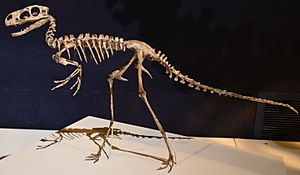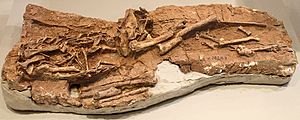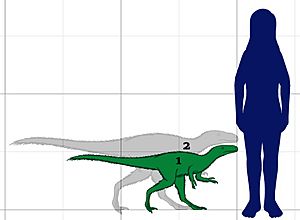Dilong paradoxus facts for kids
Quick facts for kids Dilong paradoxus |
|
|---|---|
 |
|
| Skeleton cast mount at Milwaukee Public Museum | |
| Scientific classification | |
| Genus: |
Dilong
|
| Species: |
paradoxus
|
Dilong (which means 'emperor dragon') is a type of dinosaur that lived a long time ago. It was an early relative of the mighty Tyrannosaurus rex. The only known species of this dinosaur is called Dilong paradoxus.
This dinosaur lived about 126 million years ago. It was found in the Early Cretaceous period in China. Dilong was a special discovery because it was one of the first tyrannosaur-like dinosaurs found with simple feathers.
Contents
Discovering the Emperor Dragon
Scientists Xu Xing and his team described Dilong in 2004. The name Dilong comes from Chinese words. Dì means 'emperor' and lóng means 'dragon'. The 'emperor' part refers to its connection to Tyrannosaurus rex, often called the "king" of dinosaurs. The word paradoxus means 'against what was expected'. This name was chosen because finding feathers on a tyrannosaur relative was a big surprise!
What Dilong Looked Like
The main fossil of Dilong is almost complete. It includes a skull and most of its body. This fossil is kept at the Institute of Vertebrate Paleontology and Paleoanthropology in Beijing, China.
The Dilong fossil found was about 1.6 meters (5.2 feet) long. Scientists believe it was a young dinosaur. A fully grown Dilong might have been over 2 meters (6.6 feet) long. A Dilong that was 1.3 meters (4.3 feet) long would have weighed around 6 kilograms (13 pounds).
Dinosaur Feathers
Dilong paradoxus had a covering of simple feathers. These were like fuzzy hairs, not like the feathers on modern birds. Scientists saw these feathers in fossilized skin from its jaw and tail. These feathers probably helped Dilong stay warm. They were not for flying.
Other adult tyrannosaurs found later had bumpy, scaly skin. This made scientists wonder if tyrannosaurs had different skin on different parts of their bodies. Maybe they had both scales and feathers. Another idea is that young tyrannosaurs had feathers for warmth. As they grew bigger, they might have lost their feathers and grown scales instead. This is because larger animals don't need as much insulation to stay warm.
Dilong's Place in the Dinosaur Family
When Dilong was first discovered, scientists thought it was one of the earliest and most basic members of the Tyrannosauroidea group. This group includes the much larger tyrannosaurs like Tyrannosaurus rex.
Some studies have changed their minds about where Dilong fits. But many scientists still believe Dilong is an early tyrannosauroid. This means it's a distant cousin to the famous T. rex.
| Tyrannosauroidea |
|
|||||||||||||||||||||||||||||||||||||||||||||||||||||||||||||||||||||||||||||||||||||||||||||
In 2014, one study suggested Dilong was part of a group called Proceratosauridae. However, newer studies in 2016 placed Dilong outside that group. They still saw it as an early tyrannosauroid, just a bit more advanced.
How Dilong Lived
Scientists have studied the brain of Dilong using scans. They found that Dilong's brain was S-shaped. This is different from Tyrannosaurus, which had a straighter brain. This difference might be because of their size.
Dilong's brain scans also showed it had a large flocculus. This part of the brain helps with balance and movement. This suggests Dilong was agile and had good balance. Its sense of smell was not as strong as Tyrannosaurus or other advanced tyrannosaurs.
See also
 In Spanish: Dilong paradoxus para niños
In Spanish: Dilong paradoxus para niños
- Timeline of tyrannosaur research






